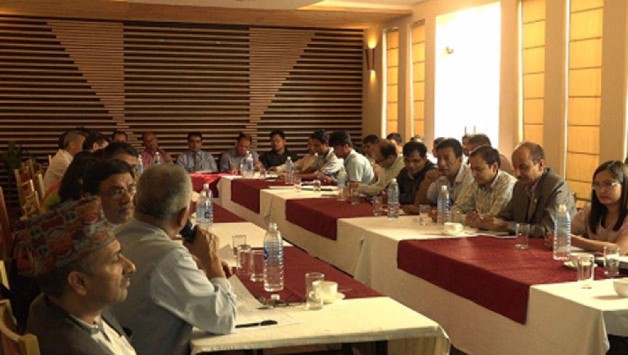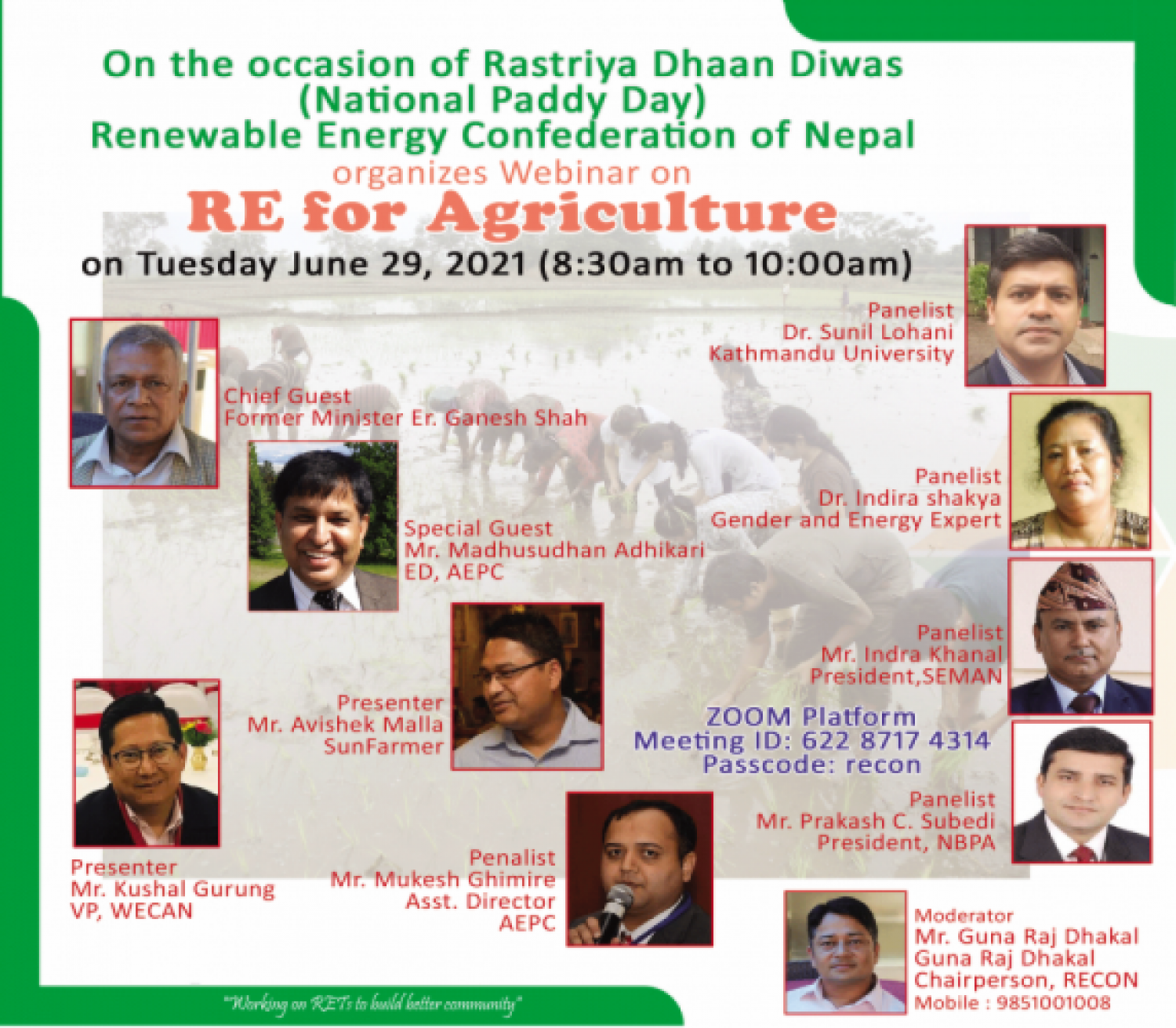
Thursday July 27, 2017, Kathmandu
Introduction
After organising successful and useful interactions, RECoN organised a Close Circle Meeting on Roles of BFIs to enhance: Banking Credits for Funding Renewable Energy (Impacts and Lessons) on Saturday, 22 July, 2017.
RECoN had organised an interactions on Roles of BFIs to enhance: Banking Credits for Funding Renewable Energy (Impacts and Lessons) on Saturday, 22 July, 2017. As a step ahead to the event of July 22, 2017, RECoN organised the second phase interaction on the same subject with wider participations for in depth knowledge sharing on Thursday July 29, 2017.
Roles of BFIs to enhance: Banking Credits for Funding RE (Impacts and Lessons)
Transmission through the national grid has been taken as 'not so easy' to stretch all over the country. Technological constraints and involvement of heavy cost are the big barriers. On top of that the energy production is yet to be enough to supply to current volume of demand.
The country has been putting efforts on energy access to people who live at off-grid locations. As such, alternative energy technologies like micro hydro, solar energy, biogas, improved cook stoves are applicated keeping in view needs and availability of resources in the given locations.
Concerned authorities say that 40 MW of electricity has been generated through micro hydro and 35 MW of electric power from solar energy systems installed in individual households and institutions. Alternative Energy Promotion Centre (AEPC) which has been active since late 1996 mentions that that 382,000 Domestic Bio-gas plants, 606,730 Solar home systems, 539 Institutional solar power system, electricity generated by Pico, Micro and Mini hydropower systems to 272,726 households, Improved Cook Stoves to 1,284,816 households and 23372 household have installed metallic improved Cook Stoves so far with AEPC initiatives in 20 years. Some other institutions including Poverty Alleviation Fund, DoLIDAR, Kadoorie also had contributed similar programmes in various locations in different styles and scales. Likewise, the recently released a biomass promotion strategy will be able to enhance efforts to make every Nepali household smoke free within 2022.
For development and promotion of renewable energy, subsidiy has been provisioned through the mobilisation of internal and external resources. The state mechanism had formulated and implemented policiies and mechanism for dispursement of subsidy to the users which played important roles in providing RE technologies to communities and individual users. Presently, state authorities and funding gencies are saying thet people and institutions now have to receive loans (soft loans) to receive suitable RE technologies minimising subsidy. The state systems also formulating policies encouraging off-grid utility systems.
After working with various modalities in the alternative energy promotion programmes, the Nepal has now to reconsider practicable working modalities. The formulated norms should be taken into consideration for all who are still deprived of sufficient energy as part of infrastructure to upgrade living standard. One problem the authorities have to recognise is that although sufficient technologies are offered in the market or say suppliers are ready to provide services and equipments, people are not made financially capable to receive them. There are provisions of subsidy to buy services and equipments. Also excellent provision for loans. But the buyers and bankers stay far away. The financial institutions who need to be in touch with the people at grass roots are not having easy connection. Therefore, dispite of presence of sufficient policies and methodlogies, a bridge between financial agencies and actual beneficiaries is a need of the hour. An additional entity, as such, must be active in between the two stakeholders or existing players need to change work patterns. In this connection, some serious people who love to see suatainable energy for all within 2030 or even before are learned to have been putting efforts in creating workable climate so as buyers get purchasing power enhanced.
The energy requirement will be based on size of the household and number of persons in the family. Thus, an appropriate and optimum size of technologies will be based on such indicators. Likewise, community based alternative energy programme will select a bigger but an optimised size of system for their energy needs.
The entity which has skill of matchmaking will also assist hoseholds and communities in getting maximum subsidy from government and other sources, optimum volume of loan at a nominal interest rate. Likewise, assistance will be provided also to plan agreeable payback period in easier emi and fund for maintenece and replacement of batteries and so on. Similarly, possibilty is high for the off-grid utility model of energy access to bring into the scope of the 'new entity'.
These days energy has been a need for all and renewable energ available resources and technologies is the solution. Such as,
- RE for Individual HHs/ Communities for (a) Lighting, (b) Cooking, (c) Health, (d) Sanitation, (e) Communication
- RE for Agriculture (a) Livestock farming, Fisheries, Horticulture, Herbs processing, (b) Processing Livestock, Fisheries, Herbs, Horticulture products, (c) Storage Livestock, Fisheries, Herbs, Horticulture products, (d) Value addition of labour and skill involved, (e) Low weight for transportation, (f) Better price in season and off season, (g) Food security, (h) Employment
- RE for Education (a) Lighting, (b) Heating / Cooling, (c) Science and technology labs, (d) Computer operating and internet,
- RE for Health services (a) Lighting, (b) Heating/ Cooling, (c) Labs, (d) Computer operating and internet
- RE for Cottage and small industries (a) Lighting, (b) Heating/ Cooling, (c) Processing, (d) Packaging, (d) Labs, (e) Computer operating and internet
- RE for Transportation (a) Ropeway, (b) Cable car, (c) Trains, Monorail, Metro, (d) Buses, Small vehicles, Motorcycles/ scooter, E bi-cycles
- RE for Communication (a) TV, radio, internet, battery charging, (b) power to stations
- RE for Environment, Climate Change, Gender, Social inclusion issues
- RE for economical activities and growth
The Interaction and Discussion Programme
The programme was facilitated by Former Minister Er. Ganesh Shah coordinated by Mr. Guna Raj Dhakal and managed by Mr. Purna N. Ranjitkar. Mr. Prem Sagar Subedi, Coordinator, CleanStart Project, UNCDF, Nepal, Mr. Manu Binod Aryal and Mr. Ram Chandra Joshee, chairperson of Nepal Microfinance Bankers' Association were the presenters. The interaction was participated in by representatives from AEPC, commercial banks, microfinance banking institutions, private sector businessmen, RE experts and academia.
Remarks by Former Minister Er. Ganesh Shah
Former Minister for Science and Technology Er. Ganesh Shah opened the floor for interactions saying that finance has been a key instrument after policy and technologies in Nepal. The country had achieved significantly in installing alternative energy technologies such as micro hydro, solar, biogas, biomass and progressing in wind also. The appropriate financing mechanism can fetch desired results as such financial aspect has been a must to review in the present context. The earlier but close circle meeting had churned out ideas to put at this interaction participated by wider circle. As such, the participants were expected to put in their knowledge and experiences for easier and effective financing for RE in the remote places which will be instrumental in access to energy and socio-economic uplifment of the people living in remote and difficult locations.
Opening remarks by RECoN Chairperson
Mr. Guna Raj Dhakal, the Chairperson of RECoN welcomed the participants in the event and elaborated the objectives. He stressed on need of effective financing modalities in renewable energy as renewable energy technologies now have been extended from simply a lighting solution to be important tools for various end uses such agriculture, small and cottage industries education, health, communication, transportation and so on. As such, the end users an individual or institution must be able to receive financial facilities by simple procedures and at comfortable interest rates. The government support to this effect should be enhanced so as faster progress could be expected.
Presentation by Mr. Prem Sagar Subedi
Mr. Prem Sagar Subedi, Coordinator, CleanStart Project, UNCDF, Nepal presented Opportunities and Options for Energy Financing in Nepal. Mr. Subedi elaborated that Financing Renewable Energy Services are connected (1) for low income households to access energy technologies, (2) for Energy companies/service providers, (3) for low income HH for house wiring and meter connection, (4) for productive application of energy services, (4) for low income HH for equity investment in energy projects, (5) for alternate financing models, (6) for mini grids, and (7) for grid connected systems. Thus, RET Market for financing during 2017/18 - 2021/22 as CREF projections is a total of NRs. 46,597,021,253. This can be predicted to be larger in ratio if effective credit mechanism were developed and the channels act fully with the spirit of service to the people at remote places who are not properly accessed and addressed.
Issues related to RET financing, according to Mr. Subedi are (1) Limited demand side activities (2) Conventional business models (3) Limited understanding about each other’s business (FSPs and ESPs), (4) MFI’s outreach as marketing channel for RETs - underutilized, (5) Weak After sales services (6) Companies are more dependent on subsidy market, (7) Limited works/research/capacity on energy solutions for enterprises, (8) Limited focus on cooking solutions (options not explored – induction cook stoves, metallic cook stoves for accessible areas etc.)
He concludes mentioning need of (1) Boarder perspective on RETs and RE financing, (2) Energy companies - need to move from subsidy focused to credit focus model, (3) Effective partnership between ESPs and FSPs, and (4) Innovative financing models
Presentation by Mr. Manu Binod Aryal
Mr. Manu Binod Aryal, Programme Officer, CREF Secretariat presented on Financing and Project Implementation Modalities: Opportunities and Challenges.
Mr. Aryal states there are opportunities in Financing in RE sector saying that (1) Population without electricity facility are 7M, (2) Population without reliable clean cooking solutions are 22M, (3) Slow grid extension and lack of reliable power, (4) ~1 billion loan p.a. AEPC projects alone, (5) Energy mix is the need: therefore market will grow, and (6) People can pay: weapon - current expenditure on energy.
Financing options can be (1) Direct financing, (2) Indirect Credit Financing through BFI to LFI to Beneficiary (for Stand-alone systems), (3) Vendor Financing (a) Vendor to LFI to Beneficiary, (b) ESCO model, he states.
The sector so far had witnessed RE Financing Initiatives as (1) Micro-hydro Debt Fund (Euro 1.15 M), (2) Biogas Credit Fund ( Euro 2.5 M), (3) Credit Financing of SHS (ESAP’s Support), (4) Central Renewable Energy Fund, (5) Policy level focus on credit and credit guarantee (RE Subsidy Policy Clause 12.4 & 13.2), and (6) DPs, NGO/INGOs, BFIs, Energy Suppliers and Other Stakeholder’s mandate on RE financing.
Mr. Aryal further states that (1) Selection of bankable sites (why finance them through different options if project is not feasible in the first place), (2) Running community based projects as business, (3) Risk sharing mechanisms (a) First Loss Guarantee Scheme, (b) Viability Gap Funding, (c) RE Challenge Fund, (d) Credit Guarantee Scheme, (e) Project and Debt Insurance, (4) Provision of Concessional Loan/Interest Subsidy etc. (5) Training, orientation and capacity building: TA (6) Quality, after-sales-service, smart meter, grid-ready projects, (7) Establishment of Special Purpose Vehicle (SPV), (8) Project Implementation under BOOT Concept/EPC, (8) Policy: NRB’s Deprived Sector Ceiling up to NPR 30 M are to be taken as instruments as way Forward.
Presentation by Mr. Ram Chandra Joshee
Chief Executive Officer of Chhimek Laghubitta Bikas Bank Limited Mr. Ram Chandra Joshee is the Chairperson of Nepal Microfinance Bankers' Association. His presentation is to be taken as the official voice of microfinance banking institutions working in Nepal.
According to Mr. Joshee, microfinace has been emerged as a poverty reduction tool in Nepal from the middle of 1970s with the implementation of the Small Farmer Development Programme. Microfinancing has been replicated of the Grameen microfinance conceived by Prof. Muhammad Yunus, the Nobel Prize Winner and the founder of Grameen Bank, Bangladesh in 1976. It is popularized as a social business throughout the world these days. In the decade of 1990s Grameen Bank system was introduced in Nepal by Central Bank, establishing five Rural Regional Development Banks. Similarly five NGOs Nirdhan, Center for Self Help Development (CSD), Neighbourhood Socitey Service Center (NSSC), Deprosc and Nerude were initiated as replication of the Grameen model in private sector.
Nirdhan Utthan Bank is first private sector microfinance bank established in 1998. Then after RMDC, DD Bank, Chhimek Laghubitta Bikas Bank, Swablamban Laghubitta Bikas Bank and Nerude Laghubitta Bikas Bank Limited have been established respectively. These five banks are promoted by their own NGOs which carried out earlier with their own microfinance activities. In 1999, new Financial Intermediary Act is brought into effect and FINGOs were restrained from mobilizing the client savings. In addition, FINGOs were realized that it is better opportunity to promote the microfinance development banks. The private sector microfinance development banks and five regional level rural development banks, the replicators of the Grameen model are having significant coverage in the microfinance market in Nepal. Other private sector microfinance development banks were established gradually.
Mr. Joshee states that impact of microfinance to the clients are (1) Easy livelihood, (2) Adding assets, (3) Aware about Education, Health, Hygiene and Nutrition, (4) Increased in leadership and confidence level, (5) Start up and expand their business through skill development training, (6) Create direct employment through different programme. (Self-discipline programme and other), and (7) Upgrade themselves as an entrepreneur.
He explains that Special features of MFDBs are (1) Targeted to the poor, (2) Door steps service, (3) Collateral less loan, (4) Supervision and Monitoring and (5) Repeated and increased volume of loan. Likewise, Focused on Women is an exclusive service.
He also shows internally active Issues and Challenges as (1) Transparency (with staff, client), (2) Lack of sufficient communication system, (3) Trade union activities, (4) Monitoring and supervision, (5) Lack of Integrated programme, (6) Proper MIS System, (7) Capacity building, (8) Staff retention, (9) Client friendly products. Likewise (1) NRB policy on interest rate, (2) Resources constraint, (3) High administrative cost for microfinance operation in hilly and remote locations, (4) Unhealthy competition among MFIs, (5) Over indebtedness of the client, (6) Lack of infrastructure (for technology and others innovated instruments), (7) Technical support to the clients in terms of their business promotion, (8) Microfinance culture, (Financial services with non financial service can uplift the deprived client as only small loan and savings are not actual purpose of microfinance, (8) Credit information bureau for MF sector are the external barriers for desired growth of microfinancing.
Discussions
The participants from micro finance banking sector stated that micro finance banks have successfully financing in renewable energy sector even in remote villages and settlements. They are not having enough funds to match the demand. As such, the government and or institutions concerned need to consider on providing funds for them to invest in renewable energy to the households and communities. They also argued that the system they are following is practicable for all and accessible to the end users. The individual or institutional users now are looking for sizable credits for renewable energy for various income generating opportunities, they added.
Keeping in view the situations portrayed by presenters and discussions from floor the organisers conclude that further interactions and discussion will be organised to deal in detail and find out suggestions to lodge at concerned authorities. As such, further, dialogues in different levels should be carried out which will bring out way out for better financing in promotion of RE as desired. The policy makers and decision makers at government sector have to be convinced and well informed about the constraints the RE sector bearing in providing access to energy for the people living in remote and difficult location where they make better living and livelihood with help of RE technologies. The socio-economic dynamics will be active as per income generating activities take a pace although at a small scale at least.
As such, fund for financing in RE should be taken seriously so as Central Renewable Energy Fund, the mandatory fund allocated for deprived sector by the commercial banks and global climate funds if availed to microfinance banks and other potential agencies will be the best solution for financing in RE. Nepal Rastra Bank, the central bank of the country may be formulating the best regulations for this effect.
During the discussions, some from commercial banks revealed that commercial banks are putting their fund in hydropower projects and health sector projects as part of serving the deprived sector. They also admit that their services at remote and far flung locations are expensive which cannot be covered by the business volume. Likewise, loan security is another problem that commercial banks can find suitable environment for investment.
The experts, during the discussions, elaborated that the successful models implemented by financing agencies should be brought in for discussions so as betterment may be added. The fund required should be made available accordingly from different sources and the government will have to be allocating sizable budget in supporting RE through microfinancing and or proper channel. The better size of fund will create wider opportunities to the target people. Thus, formulation of policy, effective implementing modalities and capacity development activities are the must to carry out at the soonest.
The noted participants spoke in the discussions are:
Mr. Bala Ram Shrestha of BSP Nepal
Mr. Bijay Pokhrel of Agriculture Development Bank
Mr. Binod Shrestha of Winrock International Nepal
Mr. Buddhi Prasad Sapkota of Sundar Nepal
Mr. Dinesh Dulal of NMB Bank
Mr. Naresh Man Pradhan of Swablamban Laghubitta
Dr. Purshottam Shrestha of CRT Nepal
Mr. Rajendra Giri of Kailash Bikas Bank
Mr. Raju Shrestha, Nepal Samachar Patra
Mr. Saurabh Rijal
Mr. Sher Bahadur Budha
Mr. Surya Prakash Hada of Sana Kisan Bikas Bank
Mr. Vishwa Bhushan Amatya, freelance RE expert
Mr. Yub Raj Guragain of Civil Bank
Mr. Yug Ratna Tamrakar of Solar Electric Manufacturers' Association
Remarks by Mr. Ram Prasad Dhital
Alternative Energy Promotion Centre (AEPC) is a Government institution established with the objective of developing and promoting renewable/alternative energy technologies in Nepal. It functions independently, and has a eleven member board with representatives from government sector, industry sector and non-governmental organizations.
The Central Renewable Energy Fund (CREF) has been established as the financial management mechanism for the renewable energy sector in Nepal under the National Rural and Renewable Energy Programme (NRREP). The overall guiding principal for the establishment of CREF is that subsidies for promotion of renewable energy technologies (RET) should gradually be phased out and replaced by credit facilities and that the management of such credit facilities should be the responsibility of the private sector.
Mr. Ram Prasad Dhital, Executive Director of AEPC, remarked that AEPC has been successful in extending technical and financial supports for promotion of renewable energy technologies in Nepal. Financial supports as subsidy had been successful and soft loan policy has been brought into effect for better practice for responsibility of vendors and other stakeholders. CREF is active in financing through commercial banks.
One fourth of the population of the country do not have access to modern energy. We should work for them to get access to energy. As such, there are scopes and finance is one important instrument to be managed so as easy financing to such population has been a big priority.
Suitable modalities and procedures are being worked out by experts to all levels of governance as per the spirits and provisions of the Constitution of Nepal. Resource management for financing, financing modalities and financing through the proper channel and monitoring will be AEPC priority, Mr. Dihtal expressed.
Conclusion
RECoN Chairperson, concluding the interactions and discussion said that providing technologies, services and equipments are ready in the market as the professionals had contributed significantly to the promotion of renewable energy in the country. Now time has come to scale up the technologies for more than use for only lighting. Availability of energy at the far flung village can contribute to socio-economic uplifitment of the people living there. Agricultural development, development of small and cottage industries, educational improvement, transportation and communication facilities can be enhanced by availing energy. As such proper attention and actions must not be delayed. Therefore following findings of the interaction and discussion programme carried out by RECoN should be taken in to serious consideration by the concerned authorities.
- Better policy and effective implementation modalities are urgently required
- Fund crunch is one barrier to finance as per present demand
- Well manage available funding sources
- Funds available now should be accessible to those who are actually working
- Sizable fund should be created from domestic and external sources
- Sizable volume of fund will be needed to address potential demand
- Fund allocated to and by commercial banks and other agencies for deprived sector should be channelized through those who are working effectively in the deprived sector.
- Monitoring agency must be efficient in quality assurance
- Microfinance banks are working effectively and efficiently
- Present rate of interest needs to be user friendly
- Staffs and workers are needed to be trained well
- Incentives to staffs and workers
- Credibility of the borrowers whether individual or institution need to be enhanced




